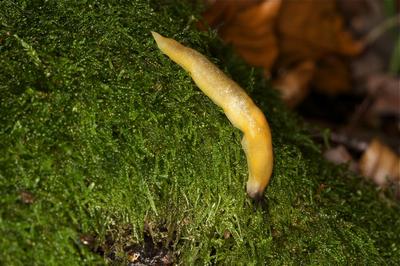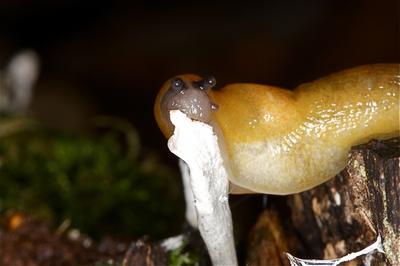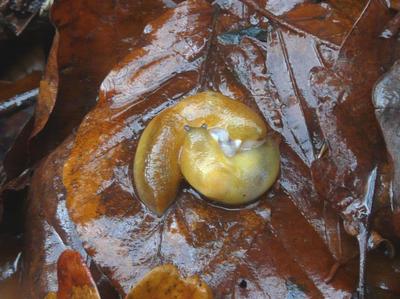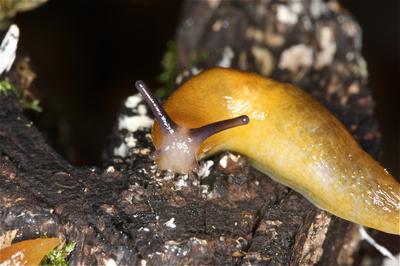There are very few records for the Lemon Slug Malacolimax tenellus in Worcestershire except for those from the Wyre Forest in recent years. This is an ancient woodland species and should be present in other parts of the county. But has anyone looked for them? There are not a lot of slug-lovers around, and so perhaps this is a group of animals that more people would like to take an interest in outside the vegetable plot?!
It is thought that for most of the year Lemon Slugs hide away under the woodland leaf litter and feed on the hyphae of a variety of different fungi. When they are mature in the autumn, and fungi are producing fruiting bodies, the adults may be found much more easily as they come up to feed and to mate.
 |
|
|
Malacolimax tenellus, The Lemon Slug © Rosemary Winnall |
|
In the Wyre Forest we are investigating their status and distribution and when fungi are fruiting we are on the look out for this attractive creature! We are noting numbers, habitat, which fungi are eaten, record dates and behaviour. So where can they be found?
A partly eaten toadstool is a good place to start and gently turning of the leaf litter over in this vicinity might be productive. Their bright yellow colouration makes these slugs conspicuous, although darker individuals have been found. They are about 4 cms. in length, the tentacles are purple/black and their mantle has a finger-print patterning. Their body slime is bright yellow and this is produced when they are agitated, such as when they are handled. It can be prolific, although in drier seasons these slugs are more reluctant to release this valuable moisture. There is a small keel at the tail end and there is no frill around the edge of the body. Small pale-coloured Arion ater slugs, and the darker Arion subfuscus may possibly cause confusion, but these both have a striped frill along the edge of the body, have no sign of a keel, and when disturbed they hunch up which Lemon Slugs do not do.
Occasionally one might find the slug eating a fungal fruiting body and valuable behavioural information can be obtained. We have so far in Wyre found Lemon Slugs associated with the following fungi– Russula ochroleuca, Xylaria hypoxylon, Peziza sp., Collybia butyracea, Stereum hirsutum, Coprinus picaceus, Pluteus cervinus, Piptoporus betulinus, Hypholoma fasciculare and Amanita fulva. We have photographed them feeding on Xylaria hypoxylon and Piptoporus betulinus and found mating pairs on the surface of beech leaf litter and on a damp log. When this species is kept in captivity it is apparently very catholic in its taste for fungi which includes mushrooms sold in supermarkets! (Rosemary Hill pers. com.) Where there is a choice of fungi, Candle Snuff appears to be ignored in my experience, but in the absence of others, this is eaten.
 |
Malacolimax tenellus, The lemon Slug |
In the Wyre Forest Lemon Slugs have been recorded primarily from areas of beech, especially those that have been thinned and contain a lot of rotting stumps and little or no ground vegetation. However, one must note that they are probably easier to spot in these conditions, so this might not give a true indication of their status! They will inhabit other types of woodland especially where there is a high incidence of dead wood, and I have found them in oak woodland, birch with hazel coppice and also in an open conifer plantation. All of these sites contain both ground deadwood and fruiting fungi. I have never found the slugs high up on trees, although they have been found occasionally near the tree base.
In the mild November of 2009 I ventured into the Wyre Forest at night with my torch and camera. In the early evening, when there was cloud cover and the temperature was still as high as 10 C, there were plenty of Lemon Slugs around and in addition the Ash Black Slug Limax cinereoniger was present, feeding particularly on the bracket fungus Piptoporus betulinus present on fallen birch branches. I was able to photograph mating pairs of Malacolimax tenellus and observe their feeding behaviour.
 |
Malacolimax tenellus, The lemon Slug |
But where are these Lemon Slugs elsewhere in Worcestershire? Can we obtain some more records from across the county? If you find one, please photograph it and send the picture to Rosemary Winnall or Harry Green along with details of location, habitat and behaviour.
Thanks to Rosemary Hill and Ron Boyce from the Conchological Society of Great Britain and Ireland for sharing information about this species and for their encouragement in our searches.
Reference:| LINDLEY DAVID 2008. Malacolimax tenellus (O.F.Muller) in Nidderdale. Mollusc World 18:20-21, (The magazine of the Conchological Society of Great Britain and Ireland) |
